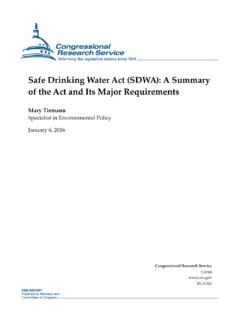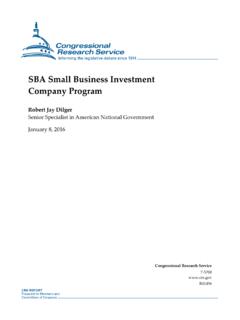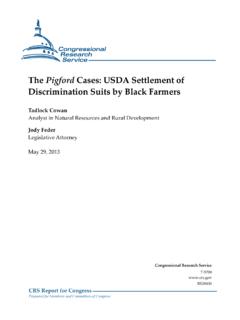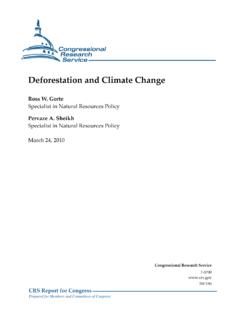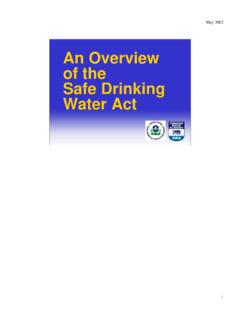Transcription of Safe Drinking Water Act (SDWA): Selected Regulatory and ...
1 safe Drinking Water Act ( sdwa ): Selected Regulatory and legislative Issues Mary Tiemann Specialist in Environmental Policy April 22, 2010. Congressional Research Service 7-5700. RL34201. CRS Report for Congress Prepared for Members and Committees of Congress safe Drinking Water Act ( sdwa ): Selected Regulatory and legislative Issues Summary Much progress has been made in assuring the quality of public Water supplies since the safe Drinking Water Act ( sdwa ) was first enacted in 1974. Public Water systems must meet extensive regulations, and Water utility management has become a much more complex and professional endeavor. The Environmental Protection Agency (EPA) has regulated some 91 Drinking Water contaminants, and more regulations are pending. In 2007, the number of community Water systems reporting no violations of Drinking Water standards was Despite nationwide progress in providing safe Drinking Water , an array of issues and challenges remain. Recent issues have involved infrastructure funding needs, Regulatory compliance issues, and concerns caused by detections of unregulated contaminants in Drinking Water , such as perchlorate and pharmaceuticals and personal care products (PPCPs).
2 Another issue involves the adequacy of existing regulations (such as trichloroethylene (TCE)) and EPA's pace in reviewing and potentially revising older standards. Congress last reauthorized sdwa in 1996. Although funding authority for most sdwa programs expired in FY2003, Congress continues to appropriate funds annually for these programs. No broad reauthorization bills have been proposed, as EPA, states, and Water systems continue efforts to implement current statutory programs and Regulatory requirements. A long-standing and overarching sdwa issue concerns the cumulative cost and complexity of Drinking Water standards and the ability of Water systems, especially small systems, to comply with standards. The issue of the affordability of Drinking Water regulations, such as those for arsenic, radium, and disinfection by-products, has merged with the larger debate over what is the appropriate federal role in assisting communities with financing Drinking Water projects needed for sdwa compliance, and for Water infrastructure improvement generally.
3 Water infrastructure financing legislation has been offered repeatedly in recent Congresses to authorize higher funding levels for the Drinking Water State Revolving Fund (DWSRF) program, and also to provide grants and other compliance assistance to small communities. In the 111th Congress, this issue found early focus in the economic stimulus debate, and the American Recovery and Reinvestment Act of 2009 (ARRA; 111-5) included $2 billion for the DWSRF. program. The Omnibus Appropriations Act, 2009, provided $829 million for this program, and the Department of the Interior, Environment, and Related Agencies Appropriations Act, 2010. ( 111-88), included an additional $ billion. The Senate Environment and Public Works Committee has reported S. 1005, a Drinking Water and wastewater infrastructure financing bill, and a bill to establish a Water infrastructure trust fund, 3202, was introduced in the House. A newer sdwa issue concerns proposals and research regarding the underground injection of carbon dioxide (CO2) for long-term storage as a means of reducing greenhouse gas emissions.
4 EPA has proposed regulations under sdwa to provide a national permitting framework for managing the underground injection of CO2 for commercial-scale sequestration projects. In August 2009, EPA published a notice of data availability and requested additional comment on the proposed rule. The Energy Independence and Security Act of 2007 (EISA; 110-140). included carbon sequestration research and development provisions, and specified that geologic sequestration activities shall be subject to sdwa provisions related to protecting underground Drinking Water sources. Another underground injection issue concerns the increasing use of hydraulic fracturing to produce natural gas from unconventional geologic formations. Bills have been introduced to authorize regulation of this practice under the sdwa underground injection control program. Congressional Research Service safe Drinking Water Act ( sdwa ): Selected Regulatory and legislative Issues Contents Introduction ..1. Last Major Reauthorization and Amendments.
5 2. Regulated Public Water Systems ..3. safe Drinking Water Act Issues ..4. Regulating Drinking Water Contaminant Candidate List ..4. Regulatory Unregulated Contaminant Monitoring ..5. Recent and Pending Rules ..7. Pharmaceuticals in Drinking Drinking Water Infrastructure Needs and Funding .. 11. Small Systems Issues .. 14. Exemptions .. 14. Small System Variances and Affordability .. 15. Affordability Criteria 15. Small System 17. Underground Injection Control 17. Carbon Sequestration and Storage .. 18. Hydraulic Fracturing .. 21. Congressional Hearings, Reports, and Documents .. 23. Additional Reading .. 23. Tables Table 1. Size Categories of Community Water Systems ..3. Table 2. Recent and Pending Regulatory Table 3. Drinking Water State Revolving Fund Program Funding, FY1997-FY2010 .. 12. Contacts Author Contact Information .. 24. Congressional Research Service safe Drinking Water Act ( sdwa ): Selected Regulatory and legislative Issues Introduction The safe Drinking Water Act1 ( sdwa ) is the primary federal law for protecting public Water supplies from harmful contaminants.
6 First enacted in 1974, and broadly amended in 1986 and 1996, the sdwa is administered through programs that regulate contaminants in public Water supplies, provide funding for infrastructure projects, protect underground sources of Drinking Water , and promote the capacity of Water systems to comply with sdwa regulations. The Environmental Protection Agency (EPA) is the federal agency responsible for administering sdwa ; however, the 1974 law established a federal-state structure in which EPA may delegate primary enforcement and implementation authority (primacy) for the Drinking Water program to states and tribes. The state-administered Public Water Supply Supervision (PWSS) program remains the basic program for regulating public Water systems, and EPA has delegated primacy for this program to all states, except Wyoming and the District of Columbia (which sdwa . defines as a state). EPA has responsibility for implementing the PWSS program in these two jurisdictions and throughout most Indian lands.
7 2. A second key portion of the act requires EPA to regulate the underground injection of fluids to protect underground sources of Drinking Water . Primary enforcement authority for the underground injection control (UIC) program also may be delegated to the states. Thirty-three states have assumed primacy for the program, EPA has lead implementation and enforcement authority in 10 states, and authority is shared in the remainder of the states. Since the law was first enacted, much progress has been made in assuring the quality of public Water supplies. EPA has regulated 91 Drinking Water contaminants, and more regulations are pending. Despite this progress, Drinking Water safety concerns and challenges remain. According to EPA's 2006 National Public Water Systems Compliance Report, the number of public Water systems reporting no violations of the health-based standards for 2006 was 93%, and 73% of the population was served by public Water systems that had no reported significant However, EPA estimated that states had submitted to the EPA database only 62% of violations of health-based standards and 29% of violations of monitoring and reporting requirements, thus increasing uncertainty as to the quality of Water provided by many systems.
8 EPA and the states have resolved some data quality and reporting problems, and efforts to address this issue continue. EPA and state compliance data indicate that Water systems still incur tens of thousands of violations of sdwa requirements each year. Although these violations primarily involve monitoring and reporting requirements, they also include thousands of violations of standards and treatment techniques. Moreover, monitoring and reporting violations create uncertainty as to whether systems actually met the applicable health-based standards. 1. Title XIV of the Public Health Service Act, as added by 93-523 and subsequently amended (42 300f- 300j-26). 2. For purposes of the PWSS program, the term state includes 57 states, commonwealths, and territories that have been approved to implement the Drinking Water program within their jurisdiction. It also includes the Navajo Nation, which received EPA approval to implement its Drinking Water program in 2000. 3. Environmental Protection Agency, Providing safe Drinking Water in America: 2006 National Public Water Systems Compliance Report.
9 Office of Enforcement and Compliance Assurance. Report No. EPA-K-09-002. March 2009. 18 p. plus appendixes. Congressional Research Service 1. safe Drinking Water Act ( sdwa ): Selected Regulatory and legislative Issues Also at issue is the rate at which EPA has been reviewing and updating existing contaminant regulations to respond to newer scientific information ( , trichloroethylene (TCE)) or to address implementation and compliance problems ( , the Lead and Copper Rule).4 Concern also exists over the potential health effects of Drinking Water contaminants for which standards have not been set, such as perchlorate and methyl tertiary butyl ether (MTBE). The act requires EPA to continually evaluate contaminants that may be candidates for regulation and to periodically review existing standards; however, EPA's perceived lack of action on specific contaminants of concern has generated criticism in Congress and elsewhere. Last Major Reauthorization and Amendments Congress last broadly revised the act with the safe Drinking Water Act Amendments of 1996.
10 ( 104-182). These changes resulted from a multi-year effort to amend a statute that was widely criticized as having too little flexibility, too many unfunded mandates, and an arduous but unfocused Regulatory schedule. Among the key provisions, the 1996 amendments authorized a Drinking Water state revolving loan fund (DWSRF) program to help public Water systems finance projects needed to comply with sdwa regulations. The amendments also established a process for selecting contaminants for regulation based on health risk and occurrence, gave EPA some added flexibility to consider costs and benefits in setting most new standards, and established schedules for regulating certain contaminants (including Cryptosporidium, disinfection byproducts, arsenic, and radon). The 1996 law added several provisions aimed at building the capacity of Water systems (especially small systems) to comply with sdwa regulations, and imposed many new requirements on the states. Among other provisions, the amendments required states to develop programs for source Water assessment, operator certification and training, and compliance capacity development.
